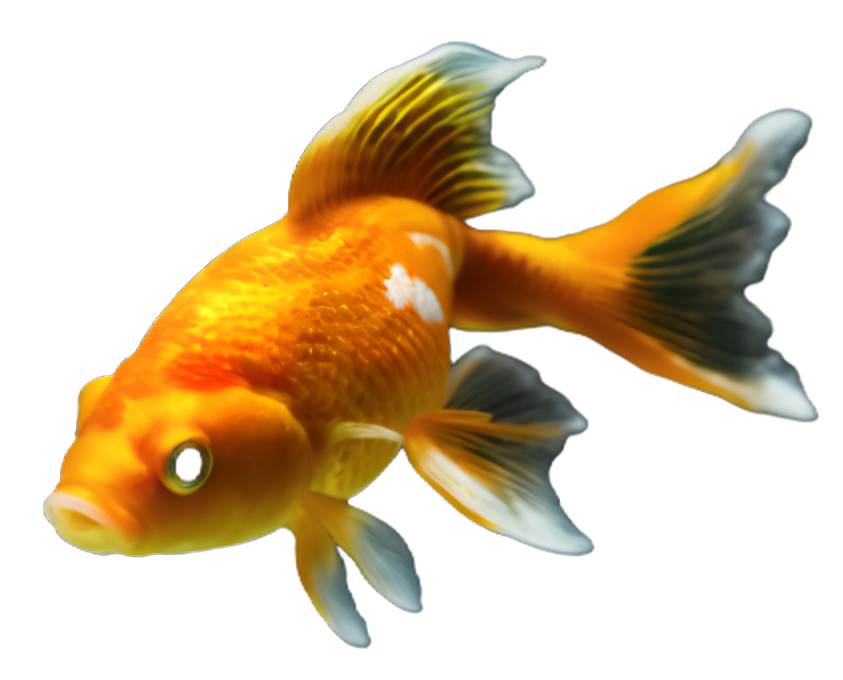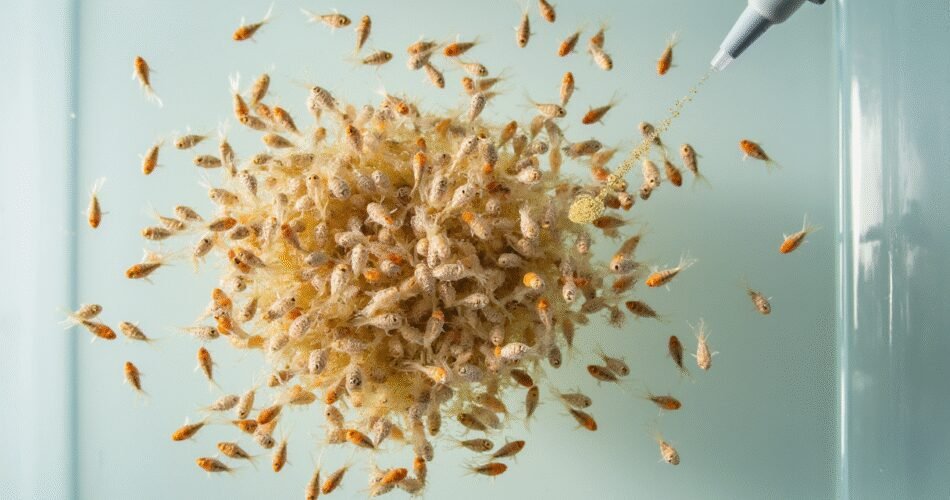Introduction to Feeding Goldfish Fry 🐠
I know how exciting it is to see those tiny goldfish fry swimming around, and I also know how nerve-wracking it can be to make sure they’re getting the right nutrition. Believe me, feeding them properly from the start is absolutely critical—it sets the stage for their health, growth, and even their color development as they mature.
In this step-by-step goldfish fry feeding guide, I’ll walk you through everything I’ve learned about raising strong, vibrant fry. We’ll cover the best foods for each stage, how often to feed, and what to watch for to keep your little ones thriving. Let’s dive in.
Understanding Goldfish Fry Nutritional Needs 🧠
When I first started raising goldfish fry, I quickly realized that their nutritional needs are way different from adult goldfish. If you want your fry to grow healthy and strong, you need to focus on three key things: protein, fats, and vitamins. Protein is absolutely essential for muscle and tissue development—I always aim for at least 50% protein in their diet, especially in the first few weeks. Fats provide energy and support cell growth, while vitamins and minerals keep their immune systems robust and help prevent deformities.
I stick to a step-by-step goldfish fry feeding guide to make sure I’m not over or underfeeding. For the first couple of days, I use infusoria or specially formulated liquid fry food because their mouths are too tiny for anything else. After that, I introduce baby brine shrimp and micro worms—these live foods are packed with nutrients and encourage natural foraging behavior. As they grow, I gradually mix in high-quality crushed flakes and pellets to diversify their diet.
Consistency is everything. I feed my fry small amounts 3–4 times a day, making sure they finish each serving within a couple of minutes. Overfeeding can foul the water and stress the fry, so I stay disciplined with portions. Clean, well-maintained water is just as important as nutrition—it helps them absorb nutrients better and reduces the risk of disease.
Trust me, paying close attention to their diet from day one makes all the difference. Healthy goldfish fry grow faster, develop brighter colors, and have a much better chance of reaching adulthood strong and vibrant.
Best Types of Food for Goldfish Fry 🍽️
When I’m raising goldfish fry, the right food makes all the difference in their growth and health. I stick to a mix of live and prepared foods to give them the best start.
First up, baby brine shrimp. This is my go-to live food for goldfish fry. They’re packed with protein, easy to digest, and the fry go crazy for them. I hatch them at home—it’s simple and ensures I always have a fresh supply.
Next, microworms. These are tiny, soft, and perfect for very young fry. I culture them in a small container—they reproduce quickly, so there’s always food available.
I also use daphnia, another live option. They’re great because they help keep the tank clean by eating excess debris, and the fry love hunting them down.
For prepared foods, I rely on powdered fry food. It’s specially formulated for small mouths and sinks slowly, so the fry have time to eat. I sometimes crush high-quality flake food into a fine powder as a convenient alternative.
Rotifers are another excellent live choice, especially for the tiniest fry. They’re nutrient-rich and help promote steady growth.
Here’s my routine: I feed small amounts multiple times a day. Live foods in the morning, prepared options later. Variety is key—it keeps the fry healthy and growing strong.
In short, baby brine shrimp, microworms, daphnia, powdered fry food, and rotifers are what work best for me. Keep it varied, keep it frequent, and you’ll see those fry thrive.
Preparing Food for Goldfish Fry 🔪
I know how tricky it can be to prepare food that’s just right for those tiny goldfish fry. They need really small, easy-to-digest meals to grow strong. Here’s what I do to make sure they get what they need.
Start with Infusoria or Liquid Fry Food
For the first few days, I use infusoria cultures or commercial liquid fry food. These are super fine and perfect for their tiny mouths. I just follow the instructions on the package or culture my own infusoria at home—it’s easier than it sounds.
Move to Powdered or Crushed Food
After about a week, I begin crushing high-quality goldfish fry food into a fine powder. I use a mortar and pestle or even the back of a spoon to make sure it’s almost dust-like. This step-by-step goldfish fry feeding guide makes it simple to adjust as they grow.
Introduce Baby Brine Shrimp
Once they’re a bit bigger, I hatch baby brine shrimp. They’re packed with protein and the perfect size. I rinse them well before feeding to keep the tank clean.
Offer Microworms or Finely Chopped Veggies
For variety, I culture microworms or finely blanch and chop veggies like spinach. I make sure everything is soft and tiny enough for them to eat easily.
Preparing food for goldfish fry isn’t hard once you get the hang of it. Just keep it small, clean, and nutritious.
Feeding Frequency and Amount for Goldfish Fry ⏰
When I first started raising goldfish fry, I quickly realized that feeding them correctly is absolutely critical for their survival and growth. Let me walk you through exactly how I do it, stage by stage.
First Week: Tiny and Frequent
For the first week after hatching, I feed my goldfish fry tiny amounts—think a pinch of powdered or liquid fry food—about 4 to 5 times a day. Their stomachs are minuscule, so overfeeding is a real risk. I make sure they finish what I give them within a couple of minutes.
Weeks 2–4: Growing Appetites
As the fry grow, I gradually increase the portion size and switch to newly hatched brine shrimp or finely crushed flakes. I still feed them 3 to 4 times daily, watching carefully to avoid leftover food that could foul the water.
Beyond One Month: Establishing Routine
By this stage, I’m feeding my goldfish fry small pellets or larger live foods twice a day. I adjust the amount based on how quickly they eat—usually within 2–3 minutes. Consistency is key here to support steady growth without compromising water quality.
Feeding Techniques for Goldfish Fry 🎯
I’ve learned that feeding goldfish fry properly is all about balance—giving them enough nutrition without messing up their water. I start with small, frequent feedings, offering tiny portions two to four times a day. This keeps the fry well-fed and minimizes waste.
I use specialized fry food or finely crushed flakes to make sure even the smallest mouths can eat. Liquid fry food or freshly hatched brine shrimp are also great options. I watch closely during feeding—if there’s leftover food after a few minutes, I know I’ve given too much. Overfeeding is a quick way to dirty the water and harm the fry.
To keep things clean, I siphon out any uneaten food right after meals. It’s a simple habit that goes a long way in maintaining good water quality. If you want a detailed breakdown, my step-by-step goldfish fry feeding guide covers everything from portion sizes to water maintenance.
Common Feeding Mistakes to Avoid ❌
I’ve seen too many well-meaning goldfish keepers make these same feeding mistakes with their fry—and I’ve made a few myself early on. Overfeeding is the big one. It’s tempting to keep offering food when they look so tiny and hungry, but leftover food decays fast, fouling the water and stressing your fry. Poor water quality from overfeeding can stunt their growth or even wipe out a whole batch.
Another common error is using food that’s too large. Fry have tiny mouths, and if they can’t eat what you’re offering, they’ll starve even with a full tank. I always make sure to crush or soak dry foods until they’re fine enough for the smallest fry to manage.
Skipping frequent, small feedings is another mistake. Young goldfish fry need to eat several times a day—their metabolisms are super fast. If you only feed once or twice, they won’t get the nutrition they need to grow strong and healthy.
Trust me, avoiding these pitfalls makes all the difference. Your fry will grow faster, stay healthier, and you’ll have far fewer losses.
Monitoring Growth and Adjusting Diet 📏
I check my goldfish fry every single day. I don’t just eyeball it—I use a small ruler or a magnifying glass to actually measure their length. I keep a simple log to track their progress; if I notice they’re not growing steadily, I know it’s time to act.
When growth seems slow or uneven, I adjust their diet. I start by increasing feeding frequency, offering smaller meals more often throughout the day. If that doesn’t help, I switch to a more protein-rich food, like baby brine shrimp or specially formulated fry powder. I always watch how they respond. If they’re active, eating well, and growing consistently again, I stick with the plan. If not, I tweak it until I see improvement. It’s all about paying close attention and being ready to adapt.
Transitioning Fry to Juvenile Goldfish Food 🔄
I start transitioning my goldfish fry to juvenile food when they’re about a month old and roughly half an inch long. At this stage, they’re growing quickly, and their nutritional needs are changing. I begin by mixing a small amount of juvenile goldfish food with their starter food. Over the next week or so, I gradually increase the proportion of juvenile food while decreasing the starter food.
I make sure to crush the juvenile pellets into fine particles so the fry can easily eat them. I feed small amounts multiple times a day and keep a close eye on how they’re responding. If I notice any fry struggling or the water getting cloudy, I slow down the transition and do a partial water change.
Clean water is crucial during this process, so I stay on top of maintenance. By the end of the second week, my fry are usually fully adjusted to the juvenile diet and ready for their next growth phase.
Conclusion and Best Practices for Feeding Goldfish Fry ✅
After going through this step-by-step goldfish fry feeding guide, here’s what I’ve learned and what I stick to for raising healthy fry. It all comes down to starting with the right food at the right time, feeding little and often, and keeping their water clean.
I begin with infusoria or liquid fry food for the first few days, then move to baby brine shrimp or microworms as they grow. I feed them small amounts 4-5 times a day, just enough that they can eat it all in a couple of minutes. Overfeeding is a big no—it clouds the water and risks their health.
I always keep an eye on water quality, doing small, frequent water changes to prevent ammonia spikes. And I watch the fry closely; if they’re active and growing, I know I’m on the right track. Consistency is key—stick with a routine, be patient, and you’ll see your goldfish fry thrive.

